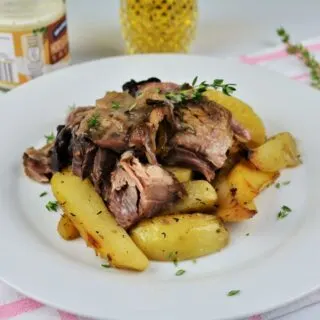I will make a delicious calorie-rich dish for those who do not want to think about their weight today. I’ll show you how to make the braised pork knuckle recipe, baked in the oven at the end and served with baked potatoes, a real men’s menu.
Table of Contents
Pork knuckle (ham hock or shank) is very popular in Hungarian cuisine, being used in many recipes for soups or stews, but also eaten as such, baked in the oven, along with beans or potatoes and horseradish cream. This is also the most famous Hungarian recipe called “csülök pékné módra” that I will try to show you in my style.
As I noticed, the recipe has two options, the one in which the knuckle is put directly in the oven and is baked over low heat for several hours, and the one I make in which the knuckle is first braised over low heat and then baked in the oven.
Let’s first review what ingredients we will use in this braised pork knuckle recipe.
Ingredients
I will use a non-smoked pork chop, about a kilogram and a half and which I will cook with skin and bone. I recommend not to debone the knuckle so that it will be much tastier and the bone can be easily removed at the end.

I will use about 1 kg of red potatoes and five yellow onions of medium-large size in the recipe. Also, five or six bay leaves, a tablespoon of peppercorns and about eight cloves of garlic.
Some of the ingredients I will use when I simmer the knuckle and some when I will bake it in the oven. But let’s take them one at a time.
How to Make the Braised Pork Knuckle Recipe?
As I said at the beginning, the braised pork knuckle recipe has two parts; first, we boil the knuckle over low heat together with the spices, and then we put it in the oven where we will bake it.
Braise the Knuckle
We need a pot for soups in which I will put the pork knuckle whole and pour enough cold water to cover the knuckle well.
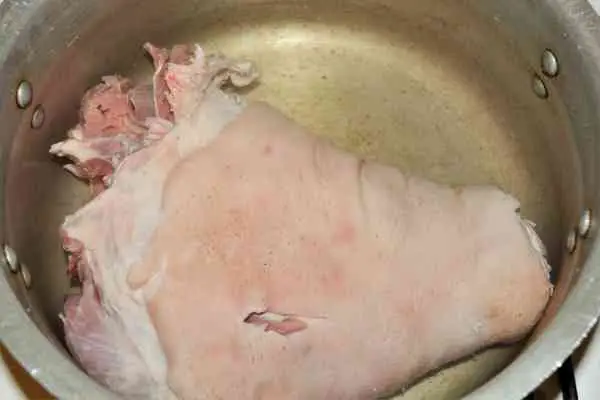
Add all the bay leaves and peppercorns to the pot, and we also add a tablespoon of sea salt. Peel two of the five onions and slice them coarsely (or just cut them into four), and put them in the pot.
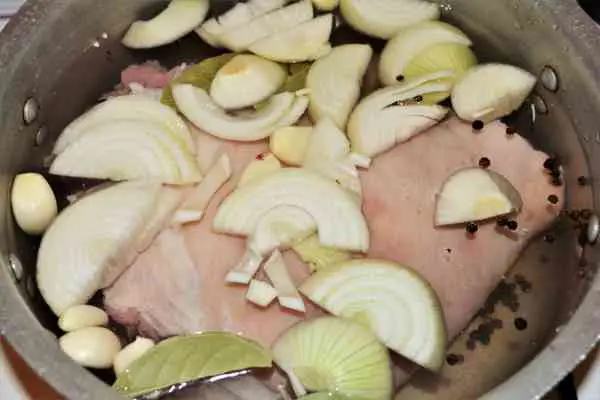
We start the fire, first at a high temperature until it starts to boil, then we reduce the temperature to a minimum and let it simmer for about two hours.
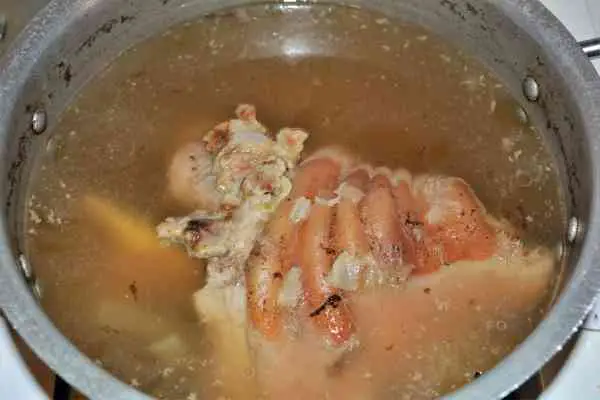
I know that, in the opinion of some, by boiling the pork knuckle beforehand, a part of the nutritional value is lost, but at the same time, the meat will be flavoured due to the spices used.
Baking the Knuckle
As a general idea, I will tell you that in a baking tray, I will make a bed of potatoes and onions over which I will place the boiled pork knuckle and bake it in the oven.
I start with the potatoes that, after I have cleaned, I will cut them coarsely; if you have smaller potatoes, cut them in four, and put them in the bowl.
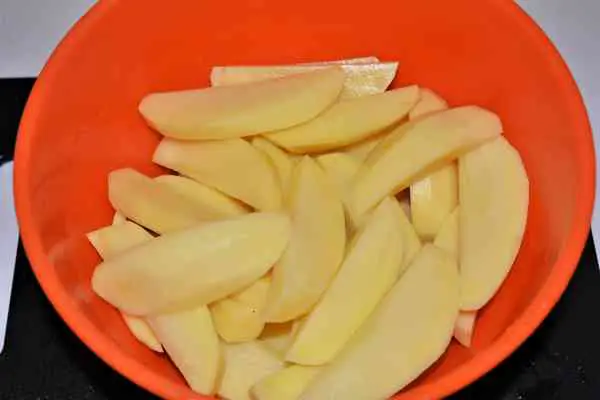
We have three onions left, which we also cleaned, coarsely sliced and put in the same bowl over the potatoes. I seasoned them with two teaspoons of sea salt, a teaspoon of freshly ground pepper, a teaspoon of marjoram, a teaspoon of thyme and three tablespoons of extra virgin olive oil.

We mix them well with a spoon or by hand as I did so that the spices reach everywhere. We prepared a baking form, I chose a ceramic tray, and I greased it with three tablespoons of lard.
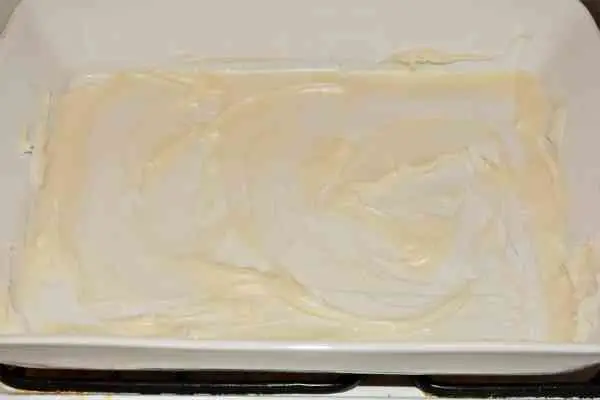
Those who do not have or do not want to use lard can use goose fat or extra virgin olive oil. In this greased tray, we will pour the mix of potatoes and seasoned onions, and we will arrange them evenly on the bottom of the tray.
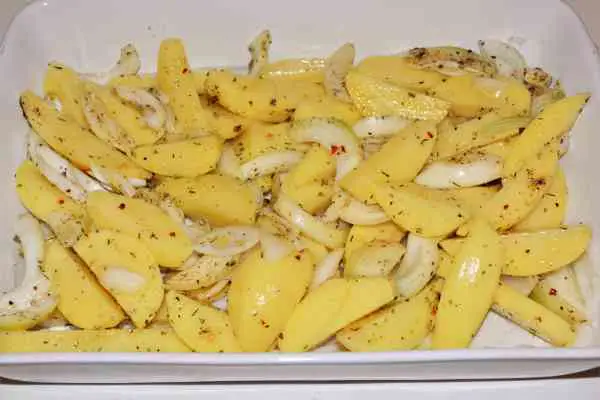
Over this mix of potatoes and onions, we will place the boiled pork chop, and we will put it in the oven. To make potatoes, I covered the tray with foil and bake them at a low temperature of 140 degrees for about 30-40 minutes.
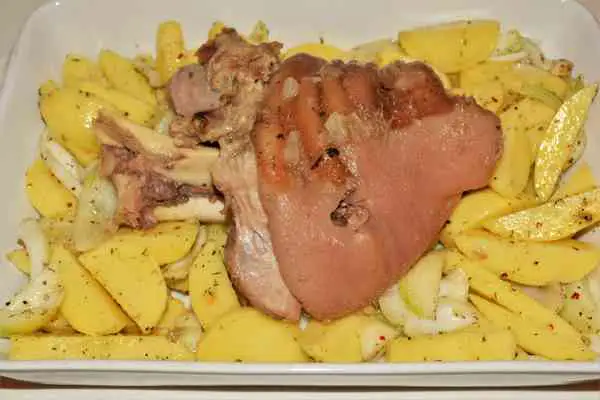
Then remove the foil, raise the temperature to 200 degrees and cook for another 20-30 minutes. To raise the recipe to another level, I mixed in a cup of 50 ml of beer with a tablespoon of honey and a teaspoon of French mustard. With this sauce, I greased the knuckle every ten minutes with a brush until it got a beautiful copper colour and the honey caramelized on top.
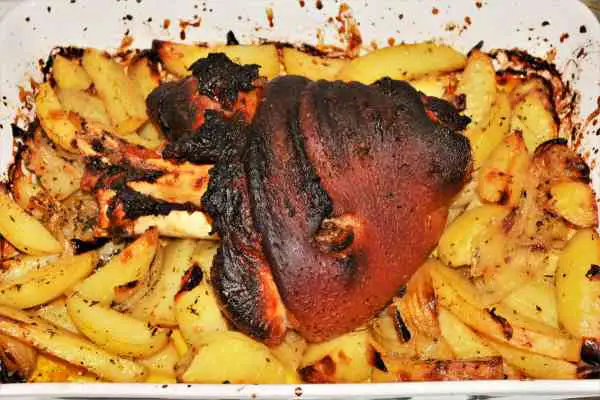
This was the braised pork knuckle recipe; the cooking time is a bit long, but believes me, it is worth it, the result will be exceptional. Let’s serve this dish!
How to Serve?
On a flat plate, we make again a bed of potatoes and sweet ripe onions over which we place strips of the perfectly cooked and braised pork knuckle, serve a little horseradish cream and pour a glass of beer next to it. Perfect for me!
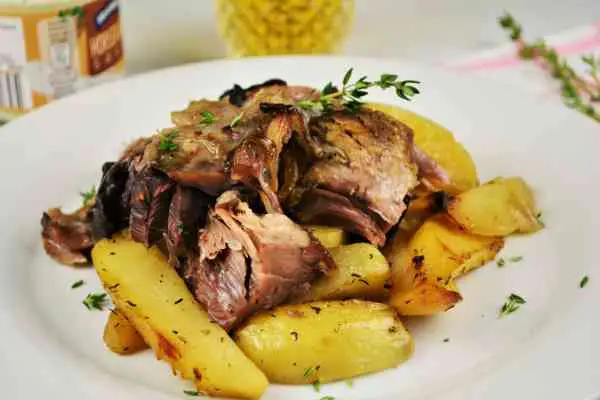
If you like this braised pork knuckle and pork in general, I recommend the following recipes from our blog:
- Easy Oven Baked Pork Steak Recipe
- Fried Breaded Pork Chops Recipe
- Best Meat Jelly Recipe
- Creamy Pork Stew Recipe
- Simple Pork Tenderloin Stew Recipe
- Best Easter Ham Recipe
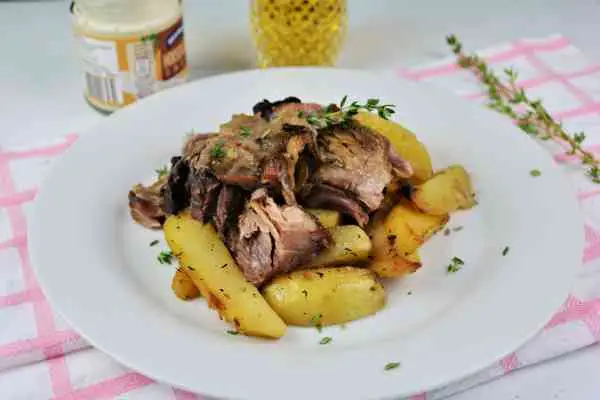
Follow Us
To keep up to date with our new recipes, don’t forget to follow us on our Facebook, Twitter, Instagram or Pinterest pages.
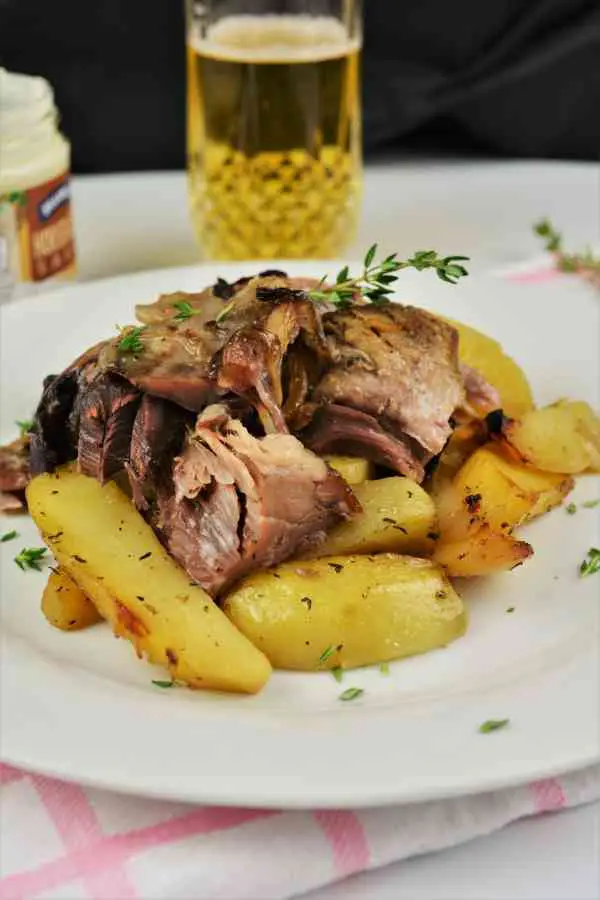
Braised Pork Knuckle Recipe
Equipment
- 1 Soup Pot
- 1 ceramic baking dish
Ingredients
- 1,5 kg pork knuckle
- 1 kg red potatoes
- 5 pieces onions medium-large size
- 6 pieces bay leaves
- 1 tbsp peppercorns
- 1 tbsp sea salt for simmering
- 1 tsp sea salt for baking
- 1 tsp ground pepper freshly ground
- 1 tsp marjoram dried
- 1 tsp thyme dried
- 3 tbsp olive oil extra virgin
- 3 tbsp pork lard or goose fat, or olive oil
- 50 ml beer
- 1 tbsp honey
- 1 tsp french mustard
Instructions
- Take a pot for soups in which put the pork knuckle so whole and over which pour enough cold water to cover the knuckle well. Add the bay leaves and peppercorns in the pot and also add a tablespoon of sea salt. Peel two of the five onions and slice them coarsely (or just cut them into four) and put them in the pot.
- Start boiling, first at high temperature until it starts to boil, then we reduce the temperature to a minimum and let it simmer for about two hours.
- Clean the potatoes, peel them and cut them coarsely, if you have smaller potatoes cut them in four, and put them in the bowl. We have three onions left, which we also cleaned, coarsely sliced and put in the same bowl over the potatoes
- Season them with sea salt, freshly ground pepper, marjoram, thyme and extra virgin olive oil. Mix them well with a spoon or by hand as I did so that the spices reach everywhere.
- Prepare a baking form and greased it well with three tablespoons of lard. In this greased tray pour the mix of potatoes and seasoned onions and arrange them evenly on the bottom of the tray. Over this mix of potatoes and onions, place the boiled pork chop and put it in the oven.
- Cover the tray with foil and bake them at a low temperature of 140 degrees for about 30-40 minutes. Then remove the foil, raise the temperature to 200 degrees and cook for another 20-30 minutes.
- Mix in a cup of 50 ml of beer with honey and French mustard. With this sauce, I greased the knuckle every ten minutes with a brush, until it got a beautiful copper colour and the honey caramelized on top.
- On a flat plate, we make again a bed of potatoes and sweet ripe onions over which we place strips of the perfectly cooked knuckle, serve a little horseradish cream and pour a glass of beer next to it.

